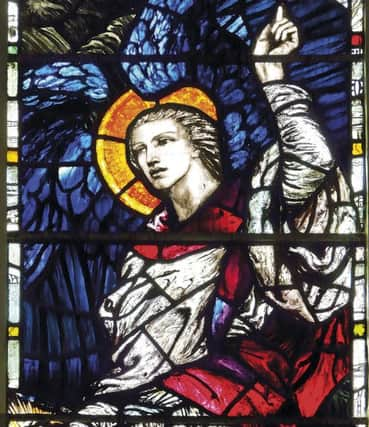Roamer: The greatest stained glass artist of her day painted with light all over Ulster


Roamer’s final page before Christmas Day 2015 displayed a photograph of Belfast stained glass window artist Wilhelmina Geddes’s Madonna and Child.
It was reproduced from Dublin academic and author Nicola Gordon Bowe’s recently published biography ‘Wilhelmina Geddes - Life and Work’.
Advertisement
Hide AdAdvertisement
Hide AdDr Bowe’s sumptuously illustrated book is about a remarkable maestro of stained glass who painted with light in Northern Ireland and around the world.
Yet she was little recounted here until now.
“Few artists can have been more unjustly forgotten,” wrote one of Nicola’s reviewers “nor better served by their biographer.”
Thomas McGreevy, a former director of the National Gallery of Ireland, described Geddes as “the most sincerely, passionately religious stained glass of our time”.
But because her craft was primarily confined to glass and lead outlines in churches and other “off the beaten track” buildings, her work couldn’t be displayed in art galleries for collective public viewing.
Advertisement
Hide AdAdvertisement
Hide AdAnd some of her best windows didn’t survive the WWII blitzes on Belfast.
Last December Roamer mentioned that Geddes shares an unusual accolade with some of history’s greatest artists, musicians and writers such as Picasso, Bach and Byron - a volcanic crater on the planet Mercury has been named after her!
Her biographer’s enthralling, intriguing and often sad book is packed with reader-friendly iconographical and biographical detail, and sometimes most poignantly, refers to Wilhelmina’s personal diaries, letters and scrapbooks.
“The moon and stars were shining,” recounted a note in her diary late in December 1910, written after walking home, alone, along the Malone Road.
Advertisement
Hide AdAdvertisement
Hide AdShe’d been at a seasonal shindig where “I nearly forgot to be miserable because nobody came to ask me if I danced.”
She didn’t know how to dance!
Methodists, particularly from the Geddes family, weren’t allowed to dance.
Bowe’s biography runs to almost 500 pages, vividly telling the story of an extraordinary Belfast artist who endured physical, mental and money problems “but the images in this book” observed the Irish Catholic magazine “often of strong saints and prophets, forceful and determined characters such as Ulster still produces, provide more than enough for the reader at home to realise that here indeed was a truly great religious artist.”
Born in 1887 in Leitrim, Geddes’s parents moved to Wellesley Avenue, Belfast, when she was two years old.
Advertisement
Hide AdAdvertisement
Hide AdShe and her three younger siblings were raised as strict Methodists in a succession of houses between the Lisburn and Malone Roads.
After some schooling in Methodist College, and doubtlessly some ‘Sunday schooling’ in University Road Methodist Church, 16-year-old Wilhelmina began her art studies in Belfast Municipal Technical Institute where she excelled over the next eight years.
It was her striking illustration in 1910 of Cinderella and an Ugly Sister that set her on her way to becoming “the greatest stained glass artist of our time” as she was described after her death in London in 1955.
Cinders, valued at three guineas, went to an art exhibition in Dublin, followed a year later by Wilhelmina, to begin specialist training in stained glass.
Advertisement
Hide AdAdvertisement
Hide AdSarah Purser, founder of the Dublin stained glass workshop An Túr Gloine (the Tower of Glass) bought Cinderella and although she remained living in Belfast, Geddes would become one of An Túr Gloine’s main designers between 1911 and 1926.
Her first two full-scale windows, completed in 1912, are both in Co Fermanagh.
Her Angel of Resurrection: ‘Why seek ye the living among the dead?’ is in St Ninnidh’s Church of Ireland, Innishmacsaint, Derrygonnelly.
Innocence Walking in the Fields of Paradise is in St Molaise’s Church of Ireland, Monea.
Advertisement
Hide AdAdvertisement
Hide AdHer strict, autocratic, lay-preacher Methodist father became addicted to laudanum and alcohol before he died in 1916, prior to which he was “noticeably more unstable and maudlin”.
Wilhelmina moved to London in 1925, to a studio in Fulham. Her personal demons encroached and she sought psychoanalysis and therapy for depression, aged 38, as a private patient in Maudsley Hospital.
Her medical notes reveal “compulsive” habits, depression and highs and lows.
But the spiritual and religious insights that effervesce from her windows will never dim.
Advertisement
Hide AdAdvertisement
Hide Ad“Mind, body and spirit in stained glass,” is the biography’s headline in publisher Four Courts Press catalogue.
Wilhelmina and a colleague were discussing a project for a window depicting Abraham and the sacrifice of Isaac from the book of Genesis.
Paintings often showed Isaac as a teenage boy, a convention that her colleague wished to follow.
Wilhelmina disagreed.
She calculated from the biblical texts that Isaac was an older man in his thirties.
Advertisement
Hide AdAdvertisement
Hide Ad“This is a very striking story,” stressed the Irish Catholic magazine. Wilhelmina’s sacrifice of Isaac is “an Old Testament type of Crucifixion. To show Isaac as about 33, the supposed age of Jesus when he died, would be to draw out the parallel. One imagines that this view would undoubtedly have appealed to the earnest Bible readers of her Belfast girlhood.”
Her windows depicting Saints Patrick and Columba, Jesus Christ with Mary and Martha and the raising of Lazarus are in Larne.
Faith, Hope and Charity, Christ blessing the little children, Moses with the ten commandments and the Parables of the Prodigal son, the wise virgins, the Talents and the Good Samaritan are in Belfast.
These are merely a few local Geddes windows.
There’ll be more on this page soon!
Full details of ‘Wilhelmina Geddes: Life and Work’ by Dr Nicola Gordon Bowe are on www.fourcourtspress.ie